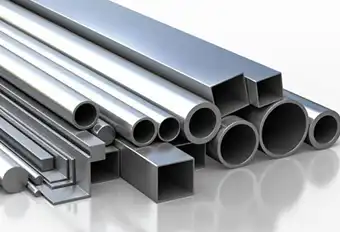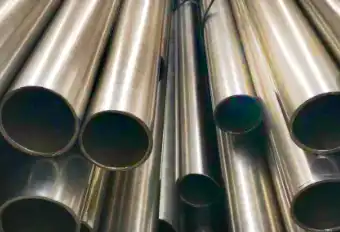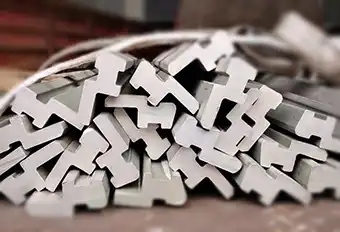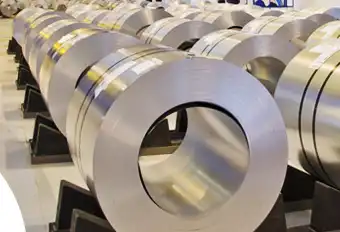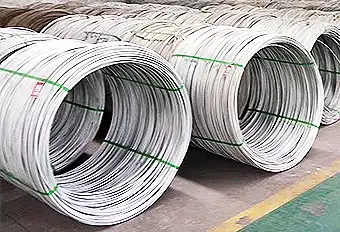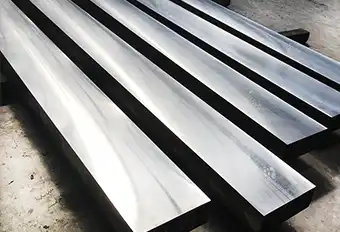A study of the constitution and structure of all steels and irons must first start with the iron-carbon equilibrium diagram. Many of the basic features of this system (Fig. 1) influence the behavior of even the most complex alloy steels. For example, the phases found in the simple binary Fe-C system persist in complex steels, but it is necessary to examine the effects alloying elements have on the formation and properties of these phases. The iron-carbon diagram provides a valuable foundation on which to build knowledge of both plain carbon and alloy steels in their immense variety.
Fig. 1. The iron-carbon diagram.
It should first be pointed out that the normal equilibrium diagram really represents the metastable equilibrium between iron and iron carbide (cementite). Cementite is metastable, and the true equilibrium should be between iron and graphite. Although graphite occurs extensively in cast irons (2-4 wt % C), it is usually difficult to obtain this equilibrium phase in steels (0.03-1.5 wt %C). Therefore, the metastable equilibrium between iron and iron carbide should be considered, because it is relevant to the behavior of most steels in practice.
The much larger phase field of γ-iron (austenite) compared with that of α-iron (ferrite) reflects the much greater solubility of carbon in γ-iron, with a maximum value of just over 2 wt % at 1147°C (E, Fig.1). This high solubility of carbon in γ-iron is of extreme importance in heat treatment, when solution treatment in the γ-region followed by rapid quenching to room temperature allows a supersaturated solid solution of carbon in iron to be formed.
The α-iron phase field is severely restricted, with a maximum carbon solubility of 0.02 wt% at 723°C (P), so over the carbon range encountered in steels from 0.05 to 1.5 wt%, α-iron is normally associated with iron carbide in one form or another. Similarly, the δ-phase field is very restricted between 1390 and 1534°C and disappears completely when the carbon content reaches 0.5 wt% (B).
There are several temperatures or critical points in the diagram, which are important, both from the basic and from the practical point of view.
- Firstly, there is the A1, temperature at which the eutectoid reaction occurs (P-S-K), which is 723°C in the binary diagram.
- Secondly, there is the A3, temperature when α-iron transforms to γ-iron. For pure iron this occurs at 910°C, but the transformation temperature is progressively lowered along the line GS by the addition of carbon.
- The third point is A4 at which γ-iron transforms to δ-iron, 1390°C in pure iron, hut this is raised as carbon is added. The A2, point is the Curie point when iron changes from the ferro- to the paramagnetic condition. This temperature is 769°C for pure iron, but no change in crystal structure is involved. The A1, A3 and A4 points are easily detected by thermal analysis or dilatometry during cooling or heating cycles, and some hysteresis is observed. Consequently, three values for each point can be obtained. Ac for heating, Ar for cooling and Ae (equilibrium}, but it should be emphasized that the Ac and Ar values will be sensitive to the rates of heating and cooling, as well as to the presence of alloying elements.
The great difference in carbon solubility between γ- and α-iron leads normally to the rejection of carbon as iron carbide at the boundaries of the γ phase field. The transformation of γ to α - iron occurs via a eutectoid reaction, which plays a dominant role in heat treatment.
The eutectoid temperature is 723°C while the eutectoid composition is 0.80% C(s). On cooling alloys containing less than 0,80% C slowly, hypo-eutectoid ferrite is formed from austenite in the range 910-723°C with enrichment of the residual austenite in carbon, until at 723°C the remaining austenite, now containing 0.8% carbon transforms to pearlite, a lamellar mixture of ferrite and iron carbide (cementite). In austenite with 0,80 to 2,06% carbon, on cooling slowly in the temperature interval 1147°C to 723°C, cementite first forms progressively depleting the austenite in carbon, until at 723°C, the austenite contains 0.8% carbon and transforms to pearlite.
Steels with less than about 0.8% carbon are thus hypo-eutectoid alloys with ferrite and pearlite as the prime constituents, the relative volume fractions being determined by the lever rule which states that as the carbon content is increased, the volume percentage of pearlite increases, until it is 100% at the eutectoid composition. Above 0.8% C, cementite becomes the hyper-eutectoid phase, and a similar variation in volume fraction of cementite and pearlite occurs on this side of the eutectoid composition.
The three phases, ferrite, cementite and pearlite are thus the principle constituents of the infrastructure of plain carbon steels, provided they have been subjected to relatively slow cooling rates to avoid the formation of metastable phases.
The austenite- ferrite transformation
Under equilibrium conditions, pro-eutectoid ferrite will form in iron-carbon alloys containing up to 0.8 % carbon. The reaction occurs at 910°C in pure iron, but takes place between 910°C and 723°C in iron-carbon alloys.
However, by quenching from the austenitic state to temperatures below the eutectoid temperature Ae1, ferrite can be formed down to temperatures as low as 600°C. There are pronounced morphological changes as the transformation temperature is lowered, which it should be emphasized apply in general to hypo-and hyper-eutectoid phases, although in each case there will be variations due to the precise crystallography of the phases involved. For example, the same principles apply to the formation of cementite from austenite, but it is not difficult to distinguish ferrite from cementite morphologically.
The austenite-cementite transformation
The Dube classification applies equally well to the various morphologies of cementite formed at progressively lower transformation temperatures. The initial development of grain boundary allotriomorphs is very similar to that of ferrite, and the growth of side plates or Widmanstaten cementite follows the same pattern. The cementite plates are more rigorously crystallographic in form, despite the fact that the orientation relationship with austenite is a more complex one.
As in the case of ferrite, most of the side plates originate from grain boundary allotriomorphs, but in the cementite reaction more side plates nucleate at twin boundaries in austenite.
The austenite-pearlite reaction
Pearlite is probably the most familiar micro structural feature in the whole science of metallography. It was discovered by Sorby over 100 years ago, who correctly assumed it to be a lamellar mixture of iron and iron carbide.
Pearlite is a very common constituent of a wide variety of steels, where it provides a substantial contribution to strength. Lamellar eutectoid structures of this type are widespread in metallurgy, and frequently pearlite is used as a generic term to describe them.
These structures have much in common with the cellular precipitation reactions. Both types of reaction occur by nucleation and growth, and are, therefore, diffusion controlled. Pearlite nuclei occur on austenite grain boundaries, but it is clear that they can also be associated with both pro-eutectoid ferrite and cementite. In commercial steels, pearlite nodules can nucleate on inclusions.


